Driver Test: TaylorMade Old M1 v New M1
Does the new TaylorMade M1 driver outperform the original?
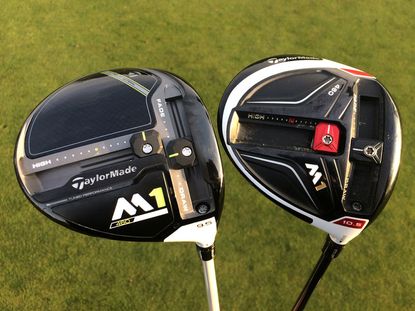

In this driver comparison test, we pit the old TaylorMade M1 driver against the new M1 to see how the overall performance compares
As always, there has been a lot of fuss made around the launch of TaylorMade’s new M1 driver and with good reason. The original M1 was an excellent performer and TaylorMade continue to dominate Tour counts week after week.
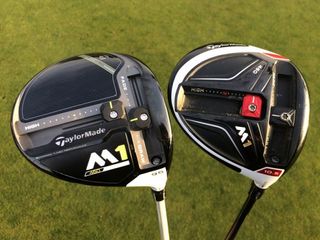
So with such a high bar set with the original M1, how could its replacement better it? Well there isn’t a new name for starters, that could get confusing. But TaylorMade claim it has made a raft of technological improvements, most notably upping the use of carbon fibre – there’s a whopping 43 per cent more in the new M1 compared to the old.
WATCH: 2017 TaylorMade M1 driver review
This has allowed TaylorMade to lengthen the back track on the T-Track system and also include a 2g heavier sliding weight. This should create greater spin and launch separation in the two extreme settings. You can also get slightly more draw or fade bias through the front sliding weight compared to the old M1.
The first difference is noticeable looking down at the two drivers at address. The titanium white section behind the clubface is much narrower on the new M1, because the crown on the new M1 uses more carbon fibre. It also appears larger and has a few extra graphics, giving it a more forgiving, high-tech appearance.
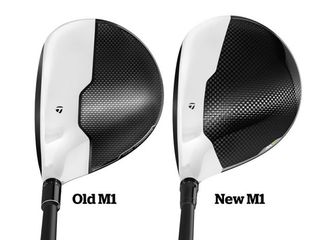
In terms of performance, there was very little between the two. With the shaft, loft and sliding weights in the same place (neutral bias, front position) the average carry was near enough identical, with the new M1 pipping the old M1 by a yard. Also notice how we achieve exactly the same ball speed and peak height with each, as well as very similar launch and spin numbers.
Get the Golf Monthly Newsletter
Subscribe to the Golf Monthly newsletter to stay up to date with all the latest tour news, equipment news, reviews, head-to-heads and buyer’s guides from our team of experienced experts.
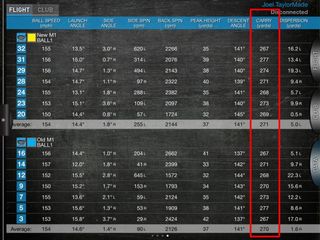
So are they different at all then? Well yes, actually they are. The first thing to point out is the ball flight. Notice how much more consistent the ball flight was with the new M1, with much tighter left and right dispersion. We think this comes from a more stable clubface on off-centre hits – we certainly felt less of a drop off in feel from the new M1 on mishits.
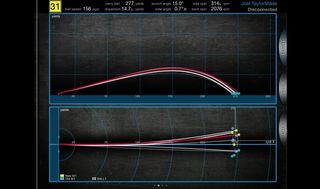
The second difference is the shot shape bias. You can also see how most of our misses with the new M1 were to the left compared to the old M1, which were pretty evenly spread left and right. This is perhaps down to the carbon fibre toe section increasing the heel weighting slightly, and thus the draw bias, something that the front weight can negate easily by being move a couple of clicks towards the toe.

Finally with the new M1, you get a greater separation of launch and spin in the two extreme back track settings. We experienced over 500 rpm more spin between the two and also an increase in launch angle of 0.6°. This just means that slower swing speeds are going to get a little more help keeping the ball in the air, widening the demographic of golfers that can maximise performance.
WATCH: 2017 TaylorMade M2 driver review
So if you’ve got the original M1, we don’t think there’s a huge reason for you to switch from old to new, but there’s no question the new TaylorMade M1 is one of the best performing drivers on the market at the moment. So if you have an R15 or something older than that, it might be worth you forking out for the upgrade this time around.

Joel has worked in the golf industry for over 12 years covering both instruction and more recently equipment. He now oversees all product content here at Golf Monthly, managing a team of talented and passionate writers and presenters in delivering the most thorough and accurate reviews, buying advice, comparisons and deals to help the reader find exactly what they are looking for. So whether it's the latest driver, irons, putter or laser rangefinder, Joel has his finger on the pulse keeping up to date with the latest releases in golf. He is also responsible for all content on irons and golf tech, including distance measuring devices and launch monitors.
One of his career highlights came when covering the 2012 Masters he got to play the sacred Augusta National course on the Monday after the tournament concluded, shooting a respectable 86 with just one par and four birdies. To date, his best ever round of golf is a 5-under 67 back in 2011. He currently plays his golf at Burghley Park Golf Club in Stamford, Lincs, with a handicap index of 3.2.
Joel's current What's In The Bag?
Driver: Titleist TSR3, 9°
Fairway wood: Titleist TSR3, 15°
Hybrid: Titleist TSi2, 18°
Irons: Ping i230 4-UW
Wedges: Titleist Vokey SM8, 54°. Titleist Vokey SM9 60° lob wedge, K Grind
Putter: Evnroll ER2V
Ball: 2023 Titleist Pro V1x
-
 'Gator Netting Is In Place' - Chevron Championship Venue Prepared For 'Safe' Winner's Jump
'Gator Netting Is In Place' - Chevron Championship Venue Prepared For 'Safe' Winner's JumpA tradition which began at the tournament's previous home could continue this year - if the champion is feeling brave enough...
By Jonny Leighfield Published
-
 New Balance 997 SL Golf Shoe Review
New Balance 997 SL Golf Shoe ReviewNew Balance produce some extremely stylish footwear and, in this review, Matt Cradock takes their spikeless 997 SL onto the course
By Matt Cradock Published